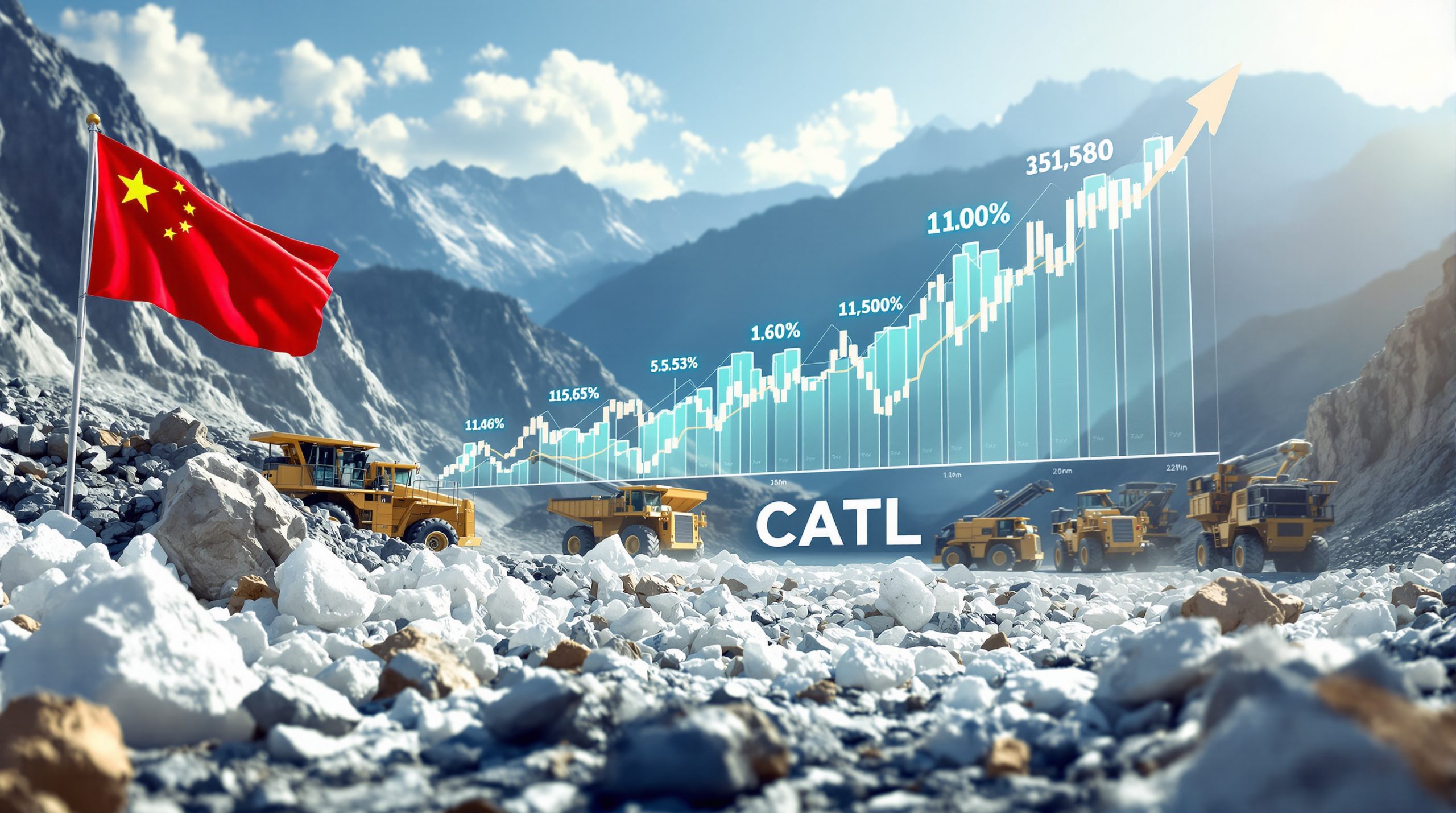How Is Codelco Boosting Copper Recovery After Years of Declining Output?
After years of struggling with declining production, Chile's state-owned copper giant Codelco is showing promising signs of recovery. The company recently reported a 9% year-over-year increase in copper production for the first half of 2025, marking a significant turnaround for the world's largest copper producer. This recovery comes at a critical time as rising copper demand continues to grow, driven by the ongoing energy transition and electrification trends.
Codelco's resurgence strategy combines operational improvements, strategic mine expansions, and technological innovation to reverse what had been the lowest production levels in 25 years. With full financial results expected on August 1, 2025, industry analysts are watching closely to see if this recovery is sustainable.
Understanding Codelco's Production Challenges and Recovery Strategy
The Current State of Codelco's Copper Production
Codelco's first-half 2025 production increase of 9% represents a significant achievement for the Chilean copper giant. This growth puts the company on track to return to its pre-pandemic production levels, which had slumped to their lowest point in 25 years during the challenging period of 2020-2023.
Chairman Maximo Pacheco announced the production increase during a ceremony marking the anniversary of the El Teniente mine, stating: "Our recovery strategy is yielding results as we continue pushing forward with projects to tap richer areas in our aging mines."
The full scope of this Codelco and copper recovery will become clearer when Codelco releases its complete financial and operational results on August 1, 2025. These results will provide crucial insights into whether the recovery is sustainable and if the company can maintain its status as the world's leading copper producer.
Historical Context of Codelco's Production Decline
Codelco's production challenges didn't emerge overnight. The company has been battling declining ore grades across its portfolio of aging mines, some of which have been in operation for over a century. This deterioration in ore quality has been a primary factor in the company's struggle to maintain production levels.
Operational setbacks further compounded these challenges, with efficiency metrics falling below industry benchmarks. Project delays, particularly during the pandemic period, significantly impacted Codelco's ability to access higher-grade ore zones that were essential for maintaining production volumes.
These combined factors threatened Codelco's long-standing status as the world's top copper supplier, with competitors like Freeport-McMoRan and BHP gaining ground in recent years. The decline was particularly concerning for Chile, where Codelco's contributions represent a significant portion of national export earnings and government revenue.
What Factors Led to Codelco's Production Decline?
Aging Mine Infrastructure Challenges
Codelco's mine portfolio includes some of the oldest continuously operating copper mines in the world. As these legacy operations have deepened, they've inevitably reached zones with lower copper grades, requiring the extraction and processing of substantially more material to produce the same amount of copper.
The increasing mining depths have necessitated new extraction technologies and approaches. For example, at Chuquicamata, transitioning from open-pit to underground mining required completely new infrastructure and mining methods. This transformation, while necessary for the mine's future, temporarily reduced production during the transition period.
Infrastructure modernization requirements across Codelco's operations have been substantial. Many facilities were designed decades ago for higher-grade ores and have required significant upgrades to efficiently process lower-grade materials. These modernization efforts have demanded substantial capital investment while simultaneously managing ongoing production.
The combination of these factors has led to higher operational costs in mature mining operations. Mining deeper, processing more material for the same copper output, and maintaining aging infrastructure all contribute to increased production costs, creating financial pressure on the company.
Project Development Setbacks
Codelco's ambitious structural projects, designed to extend mine life and access new ore bodies, have faced significant challenges:
- Budget overruns: Several major capital projects have exceeded their initial budgets by 30-50%, straining the company's financial resources
- Construction delays: Technical challenges and pandemic-related disruptions have pushed back completion timelines by years in some cases
- Access limitations: Delays in completing new mining levels have postponed access to higher-grade ore bodies
- Workforce disruptions: The COVID-19 pandemic severely impacted construction schedules and labor availability
These project development setbacks created a compounding effect on production. As existing mining areas depleted, delays in accessing new zones created a production gap that contributed significantly to Codelco's output decline.
How Is Codelco Executing Its Production Recovery Plan?
Strategic Mine Expansion Projects
At the heart of Codelco's recovery strategy is an aggressive expansion program focused on accessing higher-grade ore zones within existing mine footprints. The most notable success has been at El Teniente, where the expansion project launched ahead of schedule, providing access to significantly richer ore zones.
This strategic approach allows Codelco to leverage existing infrastructure while targeting more valuable material. According to mining industry innovation analysts, accessing ore with just 0.1% higher copper grade can translate to approximately 5-7% more copper production from the same tonnage of processed material.
Codelco has implemented several new extraction technologies to support these expansions:
- Advanced block-caving methods that enable more efficient underground mining
- Semi-autonomous drilling systems that improve precision and safety
- Enhanced fragmentation techniques that optimize ore breaking for processing
The company has also prioritized the optimization of processing facilities to improve recovery rates. New flotation cell technologies and grinding circuit enhancements have increased copper recovery percentages, allowing more copper to be extracted from the same ore.
Operational Efficiency Improvements
Alongside physical mine expansions, Codelco has implemented a comprehensive operational efficiency program. The modernization of mining equipment and systems has been a key focus, with the replacement of aging mining fleets and the introduction of more energy-efficient equipment.
Enhanced ore processing technologies have played a crucial role in the recovery strategy:
- Advanced sorting technologies: Pre-concentration of ore before processing
- Optimized reagent usage: Reducing costs while improving recovery rates
- Water recycling systems: Decreasing freshwater consumption by up to 40%
Digital mining innovations across operations have revolutionized how Codelco manages its mines. The implementation of integrated control centers allows for real-time monitoring and optimization of the entire mining process, from extraction to final product. These centers have improved coordination between different operational areas and enabled faster decision-making.
Workforce optimization and training programs have equipped Codelco's personnel with the skills needed to operate increasingly sophisticated mining systems. This human capital development has been essential for maximizing the benefits of technological investments.
What Is the Significance of El Teniente in Codelco's Recovery?
El Teniente's Strategic Importance
El Teniente holds a special place in both Codelco's operations and Chile's mining heritage. As the world's largest underground copper mine, it has been in continuous operation since 1905, making it a cornerstone of Chile's copper industry. The mine ranks as the sixth largest globally by reserve size, with estimated reserves sufficient to support operations for several more decades.
The mine's historical significance as a nationalized asset cannot be overstated. El Teniente was among the properties nationalized in the early 1970s that formed the foundation of Codelco. This historical context imbues the mine with particular importance in Chile's national consciousness.
El Teniente plays a central role in Chile's copper production history and continues to be vital to the country's economy. The mine directly employs over 4,000 workers and creates thousands of additional indirect jobs, making it a crucial economic engine for the O'Higgins Region.
El Teniente Expansion Project Details
The El Teniente expansion project, known as "Nuevo Nivel Mina" (New Mine Level), represents one of the most significant mining developments in Chile. The project is expected to increase production by approximately 100,000 tons of copper annually once fully operational, representing a substantial boost to Codelco's overall output.
The investment scale for this expansion exceeds $3.4 billion, with projected returns expected to significantly strengthen Codelco's financial position. The project's economic impact extends beyond direct copper revenues, generating substantial economic activity throughout the supply chain.
"El Teniente's expansion is not merely about maintaining production—it's about transforming how we mine copper for the next century," explained Maximo Pacheco during the mine's anniversary celebration. "The technological innovations implemented here will define Codelco's future."
The timeline for reaching full production capacity extends through 2028, with incremental increases expected as new mining sectors come online. The expansion provides access to approximately 2.2 billion tons of ore reserves that were previously inaccessible using conventional mining methods.
The technological innovations implemented in the expansion include:
- Semi-autonomous LHD (Load-Haul-Dump) equipment
- Advanced ventilation on demand systems that reduce energy consumption
- Integrated mine monitoring using IoT sensors and real-time data analytics
- Continuous conveyor systems that replace traditional truck haulage
How Does Codelco's Recovery Impact Global Copper Markets?
Influence on Global Copper Supply
Codelco's position as a major market supplier gives its production trends significant influence over global copper forecast. The company has historically supplied approximately 10% of the world's copper, making its recovery particularly important for market balance.
The effect of Codelco's production increases on global copper availability is substantial. Market analysts estimate that the company's 9% production increase in the first half of 2025 has contributed to moderating price volatility in an otherwise tight market. This production boost comes at a crucial time when global copper inventories have been at historically low levels.
Codelco and copper recovery plays a vital role in copper price stability. By increasing supply predictability, the company helps reduce speculative price movements that can adversely affect both producers and consumers. This stability is particularly important given copper's role as an economic bellwether.
The company's production revival is essential for meeting growing global demand for copper, particularly from:
- Electric vehicle manufacturing: Each EV requires 2-4 times more copper than conventional vehicles
- Renewable energy infrastructure: Wind and solar installations are copper-intensive
- Grid modernization projects: Upgrading aging power infrastructure worldwide
- Urbanization in emerging economies: Continuing development in Asia and Africa
Strategic Importance to Chile's Economy
Codelco's contributions to Chile's national revenue and exports cannot be overstated. The company typically provides between 10-15% of government revenues through taxes, royalties, and dividends. This makes Codelco's financial health directly linked to Chile's fiscal stability.
The employment generation and economic multiplier effects are substantial, with each direct job at Codelco supporting approximately 2.5 additional jobs throughout the economy. In mining regions, this employment effect is even more pronounced, with entire communities dependent on mining activity.
Foreign exchange earnings from Codelco's copper exports are crucial for Chile's macroeconomic stability. Copper represents approximately 50% of Chile's total exports, with Codelco accounting for roughly half of those copper exports. This makes the company's production recovery strategically important for maintaining Chile's trade balance.
The company's operations provide substantial support for regional development in mining communities. Beyond direct employment, Codelco's presence drives infrastructure development, educational opportunities, and service sector growth in regions that might otherwise see limited economic activity.
What Challenges Remain for Codelco's Full Recovery?
Ongoing Operational Hurdles
Despite promising signs of recovery, Codelco faces several ongoing operational challenges. Maintaining consistent production growth requires addressing multiple complex factors simultaneously. The company must stabilize operations across its portfolio while continuing to advance development projects.
Managing operating costs in an inflationary environment presents a significant challenge. Rising input costs for energy, equipment, and materials have squeezed margins across the mining industry. Codelco must balance cost control with necessary investments in future production.
Labor relations and productivity remain critical factors for sustainable recovery. The company employs approximately 16,000 direct workers and engages with multiple unions. Maintaining positive labor relations while improving productivity metrics is essential for long-term success.
Balancing short-term production with long-term sustainability requires careful planning. Codelco must avoid the temptation to maximize immediate output at the expense of mine development work that ensures future production. This balance is particularly challenging when facing pressure to quickly restore production levels.
Environmental and Social Considerations
Water management in increasingly arid regions represents one of Codelco's most pressing environmental challenges. Central and northern Chile have experienced severe drought conditions in recent years, creating competition for water resources between mining, agriculture, and community needs.
- Codelco has committed to reducing freshwater consumption by 60% by 2030
- Desalination plants are being developed for coastal operations
- Water recycling rates have improved to over 80% at most operations
- Advanced thickening technologies reduce water losses in tailings
Energy transition to renewable sources forms another key component of Codelco's sustainability strategy. The company has committed to sourcing 80% of its energy from renewable sources by 2030, reducing both costs and environmental impact. This transition includes:
- Power purchase agreements with solar and wind generators
- Development of on-site renewable generation at mine sites
- Electrification of mining equipment to reduce diesel consumption
- Implementation of energy efficiency programs across operations
Community relations and social license to operate remain fundamental to Codelco's ability to function effectively. Mining communities increasingly expect tangible benefits and meaningful consultation. The company has enhanced its community engagement programs and local development initiatives to strengthen these relationships.
Compliance with evolving environmental regulations requires ongoing adaptation. Chile has implemented increasingly stringent environmental standards, particularly regarding emissions, water usage, and mine closure planning. Codelco must continuously upgrade its environmental management systems to maintain compliance with these evolving requirements.
How Does Codelco Compare to Other Major Copper Producers?
Competitive Position Analysis
When analyzing Codelco's production compared with other top copper miners, the company has maintained its position among the top three global producers despite recent challenges. However, its lead has narrowed as competitors like Freeport-McMoRan and BHP have expanded their operations.
Codelco's cost structure relative to industry peers shows a mixed picture. The company's C1 cash costs (direct production costs) have historically been in the second quartile of the global cost curve. However, aging infrastructure and declining grades have pushed some operations toward the third quartile in recent years.
| Producer | 2024 Production (Mt) | Average C1 Cost ($/lb) | Reserve Life (years) |
|---|---|---|---|
| Codelco | 1.55 | 1.45 | ~40 |
| Freeport | 1.47 | 1.32 | ~30 |
| BHP | 1.22 | 1.28 | ~60 |
| Glencore | 1.05 | 1.52 | ~25 |
| Rio Tinto | 0.82 | 1.30 | ~35 |
Reserve quality and mine life projections remain a strength for Codelco. The company controls approximately 20% of the world's known copper reserves, providing potential for sustained production well into the future if effectively developed.
Technological innovation adoption rates have been mixed across Codelco's operations. While newer projects like Ministro Hales have incorporated advanced technologies from inception, older operations have required significant investments to modernize. The company has accelerated its digital transformation efforts but still lags behind some competitors in areas like autonomous operations.
Market Share and Industry Standing
Codelco currently ranks as the largest copper producer globally, though its market share has decreased from approximately 12% a decade ago to closer to 10% today. This relative decline reflects both Codelco's production challenges and the growth of competitors.
The company maintains significant regional influence in Latin American mining, often setting industry standards for operational practices, community relations, and environmental management. As a state-owned enterprise, Codelco's approaches often influence mining policies throughout the region.
Strategic partnerships and joint ventures have become increasingly important for Codelco's growth strategy. The company has formed partnerships with private sector companies to develop specific projects, bringing in external expertise and capital while maintaining majority control of strategic assets.
Codelco has implemented an export market diversification strategy to reduce dependence on any single market. While China remains the largest destination for Chilean copper, Codelco has strengthened its presence in other Asian markets, Europe, and North America to create more balanced export patterns.
What Are the Financial Implications of Codelco's Recovery?
Impact on Revenue and Profitability
Projected financial improvements from increased production are substantial. Analysts estimate that the 9% production increase could translate to approximately $1.2 billion in additional annual revenue at current copper price insights, significantly strengthening Codelco's financial position.
Cost management initiatives have shown promising effectiveness, with the company implementing a comprehensive efficiency program targeting a 15% reduction in C1 costs by 2027. These initiatives include:
- Optimization of mining fleet utilization
- Renegotiation of key supplier contracts
- Energy efficiency improvements
- Workforce productivity enhancements
Capital allocation between operations and development represents a critical balancing act. Codelco must maintain sufficient investment in existing operations while funding major structural projects that will secure future production. The company has prioritized projects with the highest return on investment an
Ready to Stay Ahead of Major ASX Mineral Discoveries?
Discover why significant mineral discoveries can lead to substantial investment returns by exploring Discovery Alert's dedicated discoveries page, where their proprietary Discovery IQ model transforms complex mining data into actionable investment insights. Begin your 30-day free trial today at Discovery Alert to position yourself ahead of the market.




